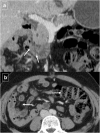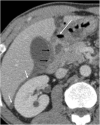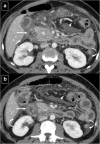Imaging of non-neoplastic duodenal diseases. A pictorial review with emphasis on MDCT
- PMID: 29388052
- PMCID: PMC5893489
- DOI: 10.1007/s13244-018-0593-6
Imaging of non-neoplastic duodenal diseases. A pictorial review with emphasis on MDCT
Abstract
A wide spectrum of abnormalities can affect the duodenum, ranging from congenital anomalies to traumatic and inflammatory entities. The location of the duodenum and its close relationship with other organs make it easy to miss or misinterpret duodenal abnormalities on cross-sectional imaging. Endoscopy has largely supplanted fluoroscopy for the assessment of the duodenal lumen. Cross-sectional imaging modalities, especially multidetector computed tomography (MDCT) and magnetic resonance imaging (MRI), enable comprehensive assessment of the duodenum and surrounding viscera. Although overlapping imaging findings can make it difficult to differentiate between some lesions, characteristic features may suggest a specific diagnosis in some cases. Familiarity with pathologic conditions that can affect the duodenum and with the optimal MDCT and MRI techniques for studying them can help ensure diagnostic accuracy in duodenal diseases. The goal of this pictorial review is to illustrate the most common non-malignant duodenal processes. Special emphasis is placed on MDCT features and their endoscopic correlation as well as on avoiding the most common pitfalls in the evaluation of the duodenum.
Teaching points: • Cross-sectional imaging modalities enable comprehensive assessment of duodenum diseases. • Causes of duodenal obstruction include intraluminal masses, inflammation and hematomas. • Distinguishing between tumour and groove pancreatitis can be challenging by cross-sectional imaging. • Infectious diseases of the duodenum are difficult to diagnose, as the findings are not specific. • The most common cause of nonvariceal upper gastrointestinal bleeding is peptic ulcer disease.
Keywords: Duodenal lesions; Duodenum; Imaging; MDCT; MRI.
Figures
























Similar articles
-
Imaging spectrum of non-neoplastic and neoplastic conditions of the duodenum: a pictorial review.Abdom Radiol (NY). 2023 Jul;48(7):2237-2257. doi: 10.1007/s00261-023-03909-x. Epub 2023 Apr 26. Abdom Radiol (NY). 2023. PMID: 37099183 Review.
-
Multimodality imaging of diseases of the duodenum.Abdom Imaging. 2014 Dec;39(6):1330-49. doi: 10.1007/s00261-014-0157-2. Abdom Imaging. 2014. PMID: 24811767 Review.
-
Duodenal tumors on cross-sectional imaging with emphasis on multidetector computed tomography: a pictorial review.Diagn Interv Radiol. 2020 May;26(3):193-199. doi: 10.5152/dir.2019.19241. Diagn Interv Radiol. 2020. PMID: 32209505 Free PMC article. Review.
-
Acquired constricting and restricting lesions of the descending duodenum.Radiographics. 2014 Sep-Oct;34(5):1196-217. doi: 10.1148/rg.345130055. Radiographics. 2014. PMID: 25208276
-
Fluoroscopic Evaluation of Duodenal Diseases.Radiographics. 2022 Mar-Apr;42(2):397-416. doi: 10.1148/rg.210165. Epub 2022 Feb 18. Radiographics. 2022. PMID: 35179986
Cited by
-
A Case of Uncomplicated Duodenal Diverticulosis Presenting With Right Upper Abdominal Pain.Cureus. 2024 Jul 8;16(7):e64062. doi: 10.7759/cureus.64062. eCollection 2024 Jul. Cureus. 2024. PMID: 39114231 Free PMC article.
-
Comparison of outcomes between complete and incomplete congenital duodenal obstruction.World J Gastroenterol. 2019 Jul 28;25(28):3787-3797. doi: 10.3748/wjg.v25.i28.3787. World J Gastroenterol. 2019. PMID: 31391773 Free PMC article.
-
Spontaneous periduodenal hematoma: a rare surgical and radiological conundrum.J Surg Case Rep. 2023 Mar 14;2023(3):rjad133. doi: 10.1093/jscr/rjad133. eCollection 2023 Mar. J Surg Case Rep. 2023. PMID: 36926625 Free PMC article.
-
Intraluminal duodenal ("windsock") diverticulum: a rare cause of biliary obstruction and acute pancreatitis in the adult.Endosc Int Open. 2019 Jan;7(1):E87-E89. doi: 10.1055/a-0808-3834. Epub 2019 Jan 15. Endosc Int Open. 2019. PMID: 30652119 Free PMC article.
-
Imaging spectrum of non-neoplastic and neoplastic conditions of the duodenum: a pictorial review.Abdom Radiol (NY). 2023 Jul;48(7):2237-2257. doi: 10.1007/s00261-023-03909-x. Epub 2023 Apr 26. Abdom Radiol (NY). 2023. PMID: 37099183 Review.
References
-
- Jayaraman MV, Mayo-Smith WW, Movson JS et al (2001) CT of the duodenum; an overlooked segment gets its due. Radiographics 21 Spec No:S147–S160 - PubMed
Publication types
LinkOut - more resources
Full Text Sources
Other Literature Sources

